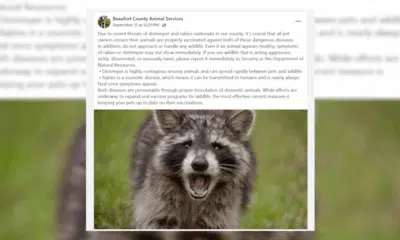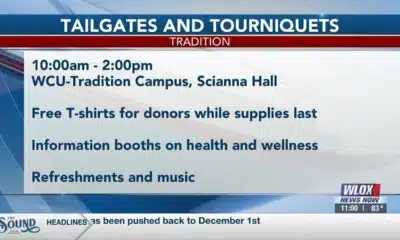News from the South - West Virginia News Feed
Morrisey signs session’s key foster care bill, vetoes other measure meant to help system in crisis
The West Virginia State Capitol (West Virginia Legislative Photography)
Gov. Patrick Morrisey has signed lawmakers’ key foster care measure into law – an omnibus bill that folded together several pieces of legislation. It includes creating a team to review the death of a foster child that occurred while in state care.
The Republican governor opted to veto other child welfare-related items, including a bill that would have provided pay raises for attorneys representing foster children. He also slashed lawmakers’ funding for a nonprofit that helps foster kids.
Lawmakers came into the 60-day session saying they must address widespread issues in the state’s troubled foster care system that is serving more than 6,000 children with a shortage of social workers, support services and safe homes for children. Too many children have ended up living in hotel rooms, and the state spent $70 million last year sending foster kids to out-of-state group homes. And, for years, the state hasn’t wanted to answer questions about what’s happening to kids in the child welfare system.
While many of the proposed bills – including one mandating an outside review of the foster system – never made it up for a vote by deadline, lawmakers behind the successful foster care measure say it’s a step in the right direction.
Foster care is a “glaring area of need in state government,” said Del. Jonathan Pinson, R-Mason, who is a foster parent.

“We made it clear that we are willing and committed to taking action … We’ve tried over the course of several years to identify areas that need attention and need work, and many of those areas got touched by [House Bill] 2880,” he continued. “There’s always work to be done, but when you look at the measure that we did get passed … I’m pleased with where we’re at.”
Senate Minority Leader Mike Woelfel, D-Cabell, called it the “most important bill of the session.”

“For all the praying we do in the Senate, these are the least among us. These are the most vulnerable people,” he said. “There was a lot of bipartisan work that went into this … It’s a really thoughtful bill. It’s going to help kids.”
But, more should have been done, he emphasized.
“This bill would hit like 20% of what we could have done during the session,” he said. “This is just a screaming issue for the little ones who have no lobbyists.”
During the Legislative Session, a federal judge dismissed a sweeping lawsuit brought by foster children against the state for alleged mistreatment in care. The judge said that the ongoing problems couldn’t be solved by the courts, and the “blame squarely lies with the West Virginia state government.”
What’s included in the bill
The foster care measure nearly died in the final hours of session last month as Senate and House members struggled to come to an agreement on what it should contain.
Woelfel told lawmakers in a conference committee hashing out the bill that they couldn’t let the session’s only foster care measure die. Lawmakers eventually agreed to remove a part of the bill that would have regulated in-state behavioral programs for children, and said they’d work on that part in a separate bill for next year.
House Bill 2880 in its final form folds together several different foster care measures from this session, including mandating that parent resource navigators, who help parents who are seeking to reunify with their children, be included in key meetings about the child’s case. Parent resource navigators are established through the court system.
West Virginia terminates parental rights at twice the rate of any other state.
“It’s always about reunification with biological mom and dad, but they don’t always get a lot of resources through navigating the complex system,” explained Del. Adam Burkhammer, R-Lewis, who sponsored the bill. Burkhammer is a foster parent.

The measure also created a Critical Incident Review Team that will review a fatality or near fatality of a child in the custody of the state Department of Human Services. The team must meet within 45 days of the fatality or near fatality to conduct the review and share a report with lawmakers and online.
“I think probably the best part of the bill is the Critical Incident Review Team and being able to put an additional set of eyes on these fatalities and near fatalities,” Pinson said, adding the goal is to help prevent future incidents. “Being able to bring in additional resources to address our response to these very serious situations is demanded.”
The bill also included some new requirements for the state’s online Child Welfare Dashboard, including additional information about the state’s Child Protective Service workforce.
Angelica Hightower, communications specialist for the Department of Human Services, said that the agency didn’t have any concerns with the bill.
“We recognize the intent of this legislation to strengthen the delivery and oversight of services within our child welfare system and broader human services framework,” she wrote in an email. “As we move toward implementation, the department is committed to working collaboratively to ensure that the measures outlined in the bill are carried out effectively and in alignment with the needs of West Virginia’s children and families.”
Lawmakers also revised childhood immunization rules for foster families in a bundle of rules changes, Burkhammer said. Foster parents will no longer be required to provide the vaccination records of their biological children as an eligibility condition to open their home to a foster child.
Both Burkhammer and Pinson said lawmakers’ failure to fix ongoing issues with the state’s voucher system, which provides money for their foster kids’ clothes and other items, was the biggest failure in foster care reform this session.
The current voucher system limits spending to only certain stores and regularly results in foster parents and kinship caregivers spending their own money to pay for clothes, beds, car seats and more.
“When parents are willing to step up and put themselves out there for foster children, we’ve got to make sure that as a state we can provide the resources that they need,” Pinson said.
Morrisey vetoes pay raise for guardian ad litems amid shortage
Morrisey vetoed House Bill 2351, sponsored by Burkhammer, which would have given public defenders and guardian ad litems a pay raise of an additional $10 per hour for in- and out-of-court work.
The state has a shortage of guardian ad litems, which are required in child welfare cases and represent the best interests of the child. The shortfall has led to cases often lingering in the court system while children await permanency.
In his veto message, Morrisey said he was “sympathetic to the intent of this bill” but noted that lawmakers had reduced his proposed funding amount for the Public Defender Services.
“I want West Virginia to be a national model for fiscal responsibility, and this bill fails to meet that objective,” Morrisey wrote. “The math does not add up. The Legislature did not fully fund this line item for the ensuing fiscal year, which necessitates the veto of this bill.”
Burkhammer emphasized that the shortage of guardian ad litems has led to “low quality of services.”
“Ulimateily, the child’s best interest is not getting the attention it deserves,” he said.
Morrisey also cut 75% of lawmakers’ allocated funding to West Virginia’s Court Appointed Special Advocates, or CASA, a program that helps foster children in the court system, before signing the budget bill.
In his veto message, the governor said the program relies on grants and could seek additional grant funding.
Woelfel believes that despite the vetoes, Morrisey is committed to foster care reform.
“I’m taking him at his word,” he said. “I think it has got to be a team effort.”
The post Morrisey signs session’s key foster care bill, vetoes other measure meant to help system in crisis appeared first on westvirginiawatch.com
Note: The following A.I. based commentary is not part of the original article, reproduced above, but is offered in the hopes that it will promote greater media literacy and critical thinking, by making any potential bias more visible to the reader –Staff Editor.
Political Bias Rating: Centrist
The content presents a balanced view on foster care reform in West Virginia, highlighting actions and positions from both Republican and Democratic lawmakers as well as the Republican governor. It reports on legislative efforts, vetoes, and critiques from multiple perspectives without strongly favoring one political ideology over another. The article emphasizes bipartisan cooperation and acknowledges shortcomings on all sides, indicating a centrist tone in its coverage.
News from the South - West Virginia News Feed
Ohio neighborhood fears landslide as retaining wall slips
SUMMARY: In Portsmouth, Ohio, a retaining wall has been slipping for about five years, causing fear among residents like the Yuri family who moved in just before the slip began. Despite support beams installed two years ago, cracks in the wall allow water to gush through, flooding parts of the road and raising concerns about a potential catastrophic landslide. Local councilman Shawn Dun highlights questions about the wall’s stability and estimates repair costs near $2 million, with the city seeking grants to fund the work. Residents anxiously await repairs, hoping the problem will be resolved soon to prevent disaster.
A cloud of concern hovers over one Portsmouth neighborhood. Those living along Richardson Road wonder how much longer a retaining wall will hold and keep a hillside from sliding that would damage their property. The support wall began slipping 5 years ago. A couple years later, support beams were put in place for a problem that those living along the street say is a ticking time bomb.
FULL STORY: https://wchstv.com/news/local/a-ticking-time-bomb-has-a-portsmouth-neighborhood-living-in-fear
_________________________________________
For the latest local and national news, visit our website: https://wchstv.com/
Sign up for our newsletter: https://wchstv.com/sign-up
Follow WCHS-TV on social media:
Facebook: https://www.facebook.com/eyewitnessnewscharleston/
Twitter: https://twitter.com/wchs8fox11
Instagram: https://www.instagram.com/wchs8fox11/
News from the South - West Virginia News Feed
Christian's Latest Forecast: More Dry Days; Rain Potential Late Next Week
SUMMARY: Storm Watch meteorologist Christian Boler reports mild, mostly dry weather continuing through the weekend with temperatures around 80°F and partly cloudy skies. A high-pressure system will maintain these warm, dry conditions into early next week. Some unorganized tropical rainstorms may bring isolated showers from Tuesday night into Wednesday morning, followed by a dry midweek. Saturday promises significant rainfall, helping to relieve recent dry and minor drought conditions affecting vegetation. Temperatures have shifted from below to above average this week but will dip below average later in the month. Overall, expect more dry days with rain potential late next week, improving moisture levels regionally.
FOLLOW US ON FACEBOOK AND TWITTER: https://facebook.com/WOAYNewsWatch https://twitter.com/WOAYNewsWatch.
News from the South - West Virginia News Feed
Road-widening project gets completion date, property issues remain unclear
SUMMARY: The Cross Lanes road-widening project, expanding Route 622 from Golf Mountain Road to Route 62 near Andrew Jackson Middle School, has resumed after a ten-month pause. Originally set for completion in June 2025, the new completion date is February 2027 due to delays caused by utility pole relocations. Construction is causing traffic congestion, especially around the Kroger turning light, which is being studied for timing adjustments. Despite frustrations, officials emphasize the long-term benefits. Property issues, including damage claims and easements, remain unresolved. Kanawha County lawmakers continue to provide updates as the project progresses.
Source
-
News from the South - Arkansas News Feed7 days ago
Group in lawsuit say Franklin county prison land was bought before it was inspected
-
News from the South - Kentucky News Feed6 days ago
Lexington man accused of carjacking, firing gun during police chase faces federal firearm charge
-
The Center Square6 days ago
California mother says daughter killed herself after being transitioned by school | California
-
News from the South - Arkansas News Feed6 days ago
Arkansas medical marijuana sales on pace for record year
-
News from the South - Alabama News Feed6 days ago
Zaxby's Player of the Week: Dylan Jackson, Vigor WR
-
News from the South - Missouri News Feed6 days ago
Local, statewide officials react to Charlie Kirk death after shooting in Utah
-
Local News6 days ago
US stocks inch to more records as inflation slows and Oracle soars
-
Local News Video6 days ago
William Carey University holds 'tailgates and tourniquets' blood drive















































